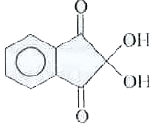Which can be oxidized to the corresponding carbonyl compound?
2-hydroxy propane
Ortho-nitro phenol
Phenol
2-methyl-2-hydroxy propane
The correct Answer is:A
To determine which compound can be oxidized to the corresponding carbonyl compound, we will analyze each option provided in the question.
1. Identify the Compounds: The options given are:
- A) 2-hydroxypropanone
- B) 2-nitrophenol
- C) Phenol
- D) 2-methyl-2-hydroxypropane
2. Understanding Oxidation:
- Oxidation of alcohols can lead to the formation of carbonyl compounds (aldehydes or ketones).
- Primary alcohols oxidize to aldehydes, and secondary alcohols oxidize to ketones.
3. Analyzing Each Compound:
- A) 2-hydroxypropanone: This is a secondary alcohol (since the hydroxyl group is attached to a carbon that is connected to two other carbons). Upon oxidation, it can be converted to a ketone (propanone).
- B) 2-nitrophenol: This compound has a hydroxyl group attached to a benzene ring. The presence of the aromatic ring and the nitro group does not allow for oxidation to a carbonyl compound.
- C) Phenol: Similar to 2-nitrophenol, phenol has a hydroxyl group attached to a benzene ring. It cannot be oxidized to a carbonyl compound due to the stability of the aromatic system.
- D) 2-methyl-2-hydroxypropane: This compound is a tertiary alcohol. Tertiary alcohols do not oxidize to form carbonyl compounds.
4. Conclusion: The only compound that can be oxidized to a carbonyl compound is A) 2-hydroxypropanone.
Final Answer:
A) 2-hydroxypropanone can be oxidized to the corresponding carbonyl compound.
- A) 2-hydroxypropanone
- B) 2-nitrophenol
- C) Phenol
- D) 2-methyl-2-hydroxypropane
- Oxidation of alcohols can lead to the formation of carbonyl compounds (aldehydes or ketones).
- Primary alcohols oxidize to aldehydes, and secondary alcohols oxidize to ketones.
- A) 2-hydroxypropanone: This is a secondary alcohol (since the hydroxyl group is attached to a carbon that is connected to two other carbons). Upon oxidation, it can be converted to a ketone (propanone).
- B) 2-nitrophenol: This compound has a hydroxyl group attached to a benzene ring. The presence of the aromatic ring and the nitro group does not allow for oxidation to a carbonyl compound.
- C) Phenol: Similar to 2-nitrophenol, phenol has a hydroxyl group attached to a benzene ring. It cannot be oxidized to a carbonyl compound due to the stability of the aromatic system.
- D) 2-methyl-2-hydroxypropane: This compound is a tertiary alcohol. Tertiary alcohols do not oxidize to form carbonyl compounds.
A) 2-hydroxypropanone can be oxidized to the corresponding carbonyl compound.
Similar Questions
Knowledge Check
- Question 1 - Select One or More
Among the following gemdiols which are stable with respect to corresponding carbonyls :
A B
B C
C D
D
- Question 2 - Select One
Which of the following carbonyl compounds is most polar ?
AC2H5−O||C−C2H5BCH3−O||C−CH3CCH3−O||C−HDH−O||C−H - Question 3 - Select One
Explain why hexacayano complexe of metals in their +2 oxidation state are usually yellow , but the corresponding hexa aqua compounds are often blue or green .
Ahexacyano complexes absorb orange or red light thus appear yellow while hexaaqua complexes absorb indigo thus appear yellowBhexacyano complexes absorb indigo thus appearing yellow while hexaaqua complexes absorb orange or red light thus appear blue or greenChexacyano complexes absorb yellow light while hexaaqua complexes absorb blue lightDCN− ions are yellow in colour while aqua ions are blue or green in colour .
Which of the following is the correct represetation for intermediate of nucleophilic addition reaction to the given carbonyl compound (A) ?
 View Solution
View SolutionAldehyde and ketones are specially susceptible susceptible to nucleophile addition because carbonyl group
_E01_580_Q01.png) (due to electronegatvity different between carbon and oxygen).
(due to electronegatvity different between carbon and oxygen).
_E01_580_Q02.png)
Positive charge on carbon makes it reactive towards the nucleophile. This addition is catalysed by acid. Reactivity of carbonyl compound towards nucleophilic addition increases in the electron deficience at carbonyl carbon. Thus, (-I.E.) group increase while (+I.E.) groups decrease the reactivity of carbonyl compound
Which among the following carbonyl compounds is most polar?View SolutionHydrogen reacts with metal oxides to give the corresponding metals.
View SolutionGrignard reagent is most suitable for preparation of which of the following with carbonyl compound ?
View SolutionGrignard reagents produce carbonyl compounds with
View Solution

